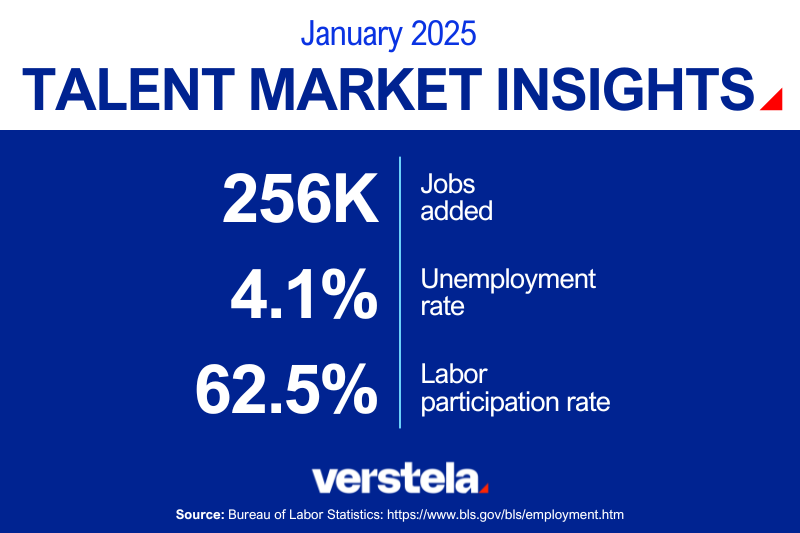
The latest jobs report provides a snapshot of how 2024 came to a close, highlighting key labor market trends.
Takeaways include:
- 256,000 jobs were added in December
- Unemployment decreased from 4.2% in November to 4.1% in December—and has remained either 4.1% or 4.2% for the last 7 months
- Workforce participation remained unchanged at 62.5%
- Wage growth increased by 0.3% month over month
Below, we dive into the data, explore what it means for employers and share strategies to stay ahead in any market.
Number of Jobs Available
December had an increase in job growth compared to previous months, capping off a year with monthly gains averaging 186,000 jobs per month. Currently, the rate of job growth is in line with growth from 2017-2019.
Industries leading in job growth were the same as previous months—in healthcare (+46,000) and government (+33,000).
Retail experienced an upswing in job growth (+43,000), reversing November’s decline ahead of the holiday season, and in contrast with Macy’s recent announcement to close 66 locations in 2025.
Employment in all other industries changed little over the month, including construction, manufacturing, warehousing and professional and businesses services.
Unemployment
Over the past year, the unemployment rate has gradually increased from 3.8% in December 2023 to 4.2% in December 2024, which, during the summer, raised questions about whether the economy is experiencing a recession.
Despite this gradual increase, it is worth noting that unemployment has remained at or below 4.2% since November 2021—a historic low not seen for such an extended period since the 1960s.
In the latest JOLTS report, which shows hires and separations for November, the number of total separations changed little at 5.1 million, while quits decreased to 3.1 million (-218,000), and the number of layoffs changed little at 1.8 million but is up by 219,000 over the year.
Wage Growth and Workforce Participation
Wage growth decreased month-over-month from 0.4% to 0.3% and over the past year, average hourly earnings have increased by 3.9%.
Workforce participation held steady at 62.5% in December, the same rate as December of last year. Since December 2021, workforce participation has remained within 62%.
However, President Donald Trump’s plans for mass deportations of undocumented workers may impact the workforce population, which accounted for 18% of the total workforce in 2023.
Economic variables to keep an eye on
The Fed voted to lower interest rates by a quarter of a percentage point during their December 2024 meeting, which could influence consumer spending.
Meanwhile, discussions of President Donald Trump’s proposed tariffs in China, Mexico and Canada are sustaining attention. This has already led to an increase in consumer spending, driven by concerns that the potential tariffs will lead to higher inflation.
Winning Moves for Employers
In today’s evolving job market, employers must adapt their strategies to attract top talent, retain their workforce, and stay ahead of economic shifts.
Here are some actionable tips for success:
- Prioritize retention amid workforce trends. With unemployment remaining historically low, retaining experienced employees is essential. Effective retention strategies should address diverse workforce needs, such as financial wellness programs for those approaching retirement and flexible career paths for employees seeking better work-life balance.
- Stay competitive with targeted recruitment efforts. The increase in unemployment and steady workforce participation provide access to a broader talent pool. Focus on attracting skilled workers with experience in logistics, manufacturing, and warehousing. Emphasize opportunities for career stability and growth to engage candidates effectively.
- Plan for external workforce shifts. Tariff discussions and inflation concerns have been linked to changes in consumer behavior. It’s important to monitor potential ripple effects on demand and adjust workforce planning to stay resilient.
- Leverage contingent staffing solutions. As economic uncertainty continues, temporary staffing solutions can provide flexibility in managing workforce needs, particularly in sectors experiencing demand fluctuations like manufacturing. Partnering with a staffing agency ensures businesses have the resources to remain agile and productive.
Looking for more resources? Explore our employer resource center. There, you’ll find an archive of on-demand HR webinars, tools and articles to help you address a variety of workplace challenges.
For additional insights into market trends, or if you need staffing support, contact us.


